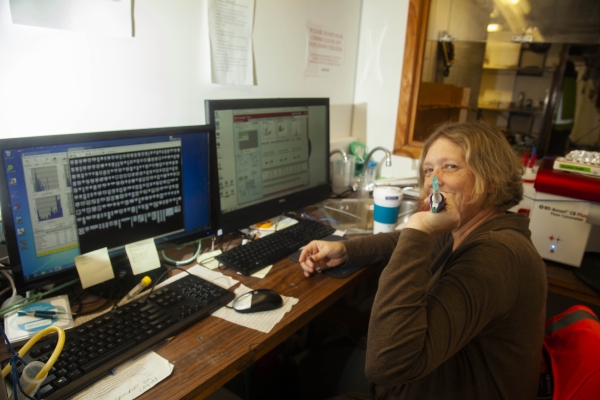8 November 2018. By Voyage Leader Dr Moira Decima.
We have been talking a lot about salps, and their effect on the ecosystem. However, there would be no life in the sea without the tiny plant-like plankton – the phytoplankton!
These microscopic cells use energy from the sunlight to grow, and are responsible for the energy that gets to all animals in the open ocean, from copepods, to salps, to fish and to whales. Lots of phytoplankton means lots of food for a lot of different types of animals!
On the ship, Dr Karen Selph (University of Hawaii) looks at how many phytoplankters there are in different areas, and at different depths, as well as their size and can sometimes even tell what type of phytoplankton there are! She uses a machine called a Flow-Cytometer, which uses a laser to see the chlorophyll inside the phytoplankton cells, and lets her count how many cells are in the water. The light shined on the phytoplankton also produces a shadow, and the size of the shadow is proportional to their cell size, so we can count and size at the same time!
The size of the phytoplankton is very important. In lots of places they may be too small for copepods or krill to eat them, which means that those areas are also not good for whales and other animals that prefer crustacean plankton. But salps eat small phytoplankton too! We are studying what they prefer, and how much they care about what phytoplankton dominate the community.
We also can get pictures of large phytoplankton and microzooplankton (tiny zooplankton) using another cool machine called the FlowCam. This machine takes pictures of the larger phytoplankton and microzooplankton, so we can actually see them. Look at all that can be held in a few drops of seawater!
Phytoplankton – the base of the food chain!
We have been talking a lot about salps, and their effect on the ecosystem. However, there would be no life in the sea without the tiny plant-like plankton – the phytoplankton! These microscopic cells use energy from the sunlight to grow, and are responsible for the energy that gets to all animals in the open ocean, from copepods, to salps, to fish and to whales. Lots of phytoplankton means lots of food for a lot of different types of animals!
On the ship, Dr Karen Selph (University of Hawaii) looks at how many phytoplankters there are in different areas, and at different depths, as well as their size and can sometimes even tell what type of phytoplankton there are! She uses a machine called a Flow-Cytometer, which uses a laser to see the chlorophyll inside the phytoplankton cells, and lets her count how many cells are in the water. The light shined on the phytoplankton also produces a shadow, and the size of the shadow is proportional to their cell size, so we can count and size at the same time!
The size of the phytoplankton is very important. In lots of places they may be too small for copepods or krill to eat them, which means that those areas are also not good for whales and other animals that prefer crustacean plankton. But salps eat small phytoplankton too! We are studying what they prefer, and how much they care about what phytoplankton dominate the community.
We also can get pictures of large phytoplankton and microzooplankton (tiny zooplankton) using another cool machine called the FlowCam. This machine takes pictures of the larger phytoplankton and microzooplankton, so we can actually see them. Look at all that can be held in a few drops of seawater!


